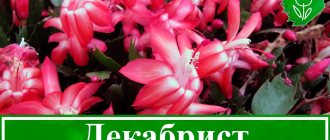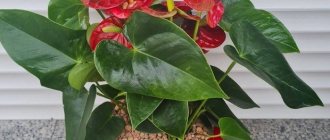The plant, which is popularly known as Decembrist or Rozhdestvennik, is scientifically called epiphyllum, zygocactus and schlumbergera. It represents the Cactus family. I fell in love with the flower primarily because its peak bloom occurs during the New Year holidays.
Many are surprised when they find out that the Decembrist refers to cacti. People are accustomed to meaning by this word something prickly, afraid of waterlogging and loving good lighting.
Decembrist belongs to the Cactus family
But this plant destroys existing stereotypes and captivates with its beauty.
Varieties of zygocactus
Since Decembrist is a relative of cacti, thanks to the painstaking work of breeders, there are a large number of subspecies, which differ from each other in the shape of the bud, their color, and the shape of the segments:
- Madame Butterfly;
- Orsichiana;
- Mix;
- Golden cream;
- Aspen;
- Buckley;
- Rousseliana;
- Gartner;
- Microfaerica;
- Prickly pear;
- Laverdendall;
- Christmas fantasy, etc.
There are ampelous types of Decembrist flowers, in which case they are grown in hanging flower pots or in special devices so that the leaves fall freely. A relative of Schlumbergera is Rhipsalidopsis (Easter). It differs in flowering time - April-May.
Secrets of lush flowering
The secrets are simple, but it’s worth learning the intricacies of caring for a flower. Then photos of exotic Decembrist flowers will delight your loved ones.
Signs and superstitions
Beliefs and predictions are associated with the Decembrist, as with other indoor plants:
- if flowering begins on time, relationships with relatives will improve;
- if it started earlier, new interesting acquaintances will appear;
- if at an atypical time, there will be a new addition to the family.
Rozhdestvennik is a donor who gives residents well-being, peace, and vitality.
Botanical description
Schlumbergera is an epiphytic cactus. It looks like a small herbaceous shrub with drooping, jointed stems, at the tips of which flowers bloom. Propagates well by shoots. It is widely used in breeding activities.
There are erect specimens, but most varieties of Decembrist have drooping shoots. Because of this, Rozhdestvennik is grown as an ampelous plant.
Lighting
The Decembrist plant loves a bright place, but without direct burning rays. This means that it can be installed on all sides of the world except the north. To prevent the sun's rays from falling on the delicate leaves, shade them with something.
In summer, it is useful to take it out onto the balcony or loggia. Do not forget to rotate the pot around its axis to avoid one-sided distribution of the green mass.
In winter, it is advisable to use additional lighting with a fluorescent or LED lamp.
History of the creation of the species
Decembrist Gold Charm is the first yellow plant variety. This species was obtained through the efforts of the American breeder R. L. Cobia in the 80s of the last century. The difficulty of breeding was that in nature there are species with an orange-red tint, but not with yellow ones.
First of all, species with a predominance of yellow over red were selected, since orange is a combination of red and yellow. As a result, about 50 thousand seeds were obtained. But only 1 plant of them had a yellowish color, although the bush itself was very weak.
To correct this, the plant was re-crossed, but with a white variety of the crop, characterized by a strong skeleton and a long flowering period. Of the 150 specimens ultimately received, only 1 flower had a soft yellow color, but the bush was well formed and had strong shoots. It was this plant that became the basis of the Gold Charm variety.
Watering
How to properly water a Decembrist flower? It needs abundant watering when buds set and flowering occurs (November-January), but such that moisture does not pour out through the drainage holes.
With such waterlogging, not only will the roots begin to rot, but also the microelements necessary for the formation of color will be washed out. During the rest of the period, water once a week, in the summer 2-3 times so that the soil surface has time to dry.
Many amateur gardeners use soil moistening through a tray; in this case, the soil does not lose its structure, microelements are not washed out when overwatered, the roots do not rot and absorb as much moisture as they need. The water should be either rainwater or centralized settled water.
Features of caring for the Decembrist at home
Schlumbergera does not like direct sunlight, so it is better to place it in the shade. In intense light, the zygocactus will turn yellow and begin to wither.
The suitable temperature regime for the existence of the Decembrist varies from 2°C to 38°C. But the plant will be able to grow more intensively at a temperature of 18-30°C. Air humidity should be moderate.In terms of juiciness, Decembrists are inferior to other types of cacti. They need watering, like all deciduous trees.
If you see a slightly dry top of the earth, you can safely water the flower. Drainage will relieve it of excess moisture and prevent its excess.
Schlumbergers are not demanding in terms of recharge. 1 ruble is enough. per week if the plant is greenhouse. When growing a plant at home, 2-4 rubles is enough. in year. As a fertilizer, a high-quality mixture of nitrogen with potassium, phosphorus and other substances is used, soluble in water and balanced in a ratio of 20:20:20, respectively.
Moderate moisture will saturate the soil with necessary substances. A month before the appearance of the rudiments of buds, fertilizing should be stopped.To improve the shape of the Decembrist, you need to pinch off the regrown parts of the stems after flowering. Choose a place to pinch, pinch the bottom with two fingers, and pinch off the top in a circular motion. It will be possible to separate two parts of the stem at once. Don't cut!
Plucking will have double benefits:
- the flower will bloom even more;
- the stems will become powerful and flower-bearing.
Proper maintenance and care of Decembrists will ensure many years of life and prosperity. Individual cases prove that zygocactus can grow and bloom for 20 years or more. During this period the trunk becomes wood-like.
Using the grafting method, you can create a standard-shaped Decembrist with unusually abundant flowering.
It is better to graft Decembrist onto Peireskia, the top of which is cut off, a cleft is made in the remaining part of the top and a shoot with 2-3 Schlumbergera segments is placed there. They are pinned together and the grafted area is wrapped with wool thread. It must be removed when the plants have grown together and all the leaves have been removed from the peirescia.
- Clarkia graceful - varieties and types, care and planting, diseases + 78 photos
- Irises - description of the species, cultivation, reproduction + 102 photos
- Campsis - planting, care, location rules, watering, types of reproduction (67 photos + video)
The Decembrist crown, which has developed over time, must be tied to the base to avoid breaking off. For planting Decembrist flowers, soil made of turf, leaves and sand (1:1:1) is favorable; an equivalent addition of peat or cultivation only in peat is possible.
Temperature
Since zygocactus comes from the tropics, it loves air humidity and tolerates high temperatures. Therefore, tolerance ranges from 2°C to 40°C. It is unlikely that there will be such temperature changes in room mode.
The optimal temperature in winter and spring is 12-16°C, in summer – 18-26°C, during flowering 16-18°C. By showering, the leaves will not only be saturated with moisture, but the dust will also be washed away, and in the summer it will help to cool down. This procedure cannot be carried out only during flowering.
general information
In fact, Decembrist or Schlumbergera is an epiphytic cactus native to the Brazilian tropics. It grows on other trees and stores moisture and nutrients abundantly in its segmented stems. Another name for Decembrist is zygocactus.
Unlike many epiphytes, Decembrist is not a parasite. He simply clings to trees and hides in their shade, but gets his own food. The average length of the shoots is about 40 cm, and they consist of flat, jagged or rounded links. New segments gradually grow from existing segments, and in winter buds appear at the tips of the stems.
Pink and red Decembrists are most often found, but breeders have already managed to develop a greater variety of shades. The flowers are multi-tiered, bizarre funnel-shaped, up to 8 cm and up to 30 petals each.
Photo: mandarin-shop.ru
The soil
The soil can be purchased either at a flower shop - soil for succulents (plants with fleshy stems), or you can make it yourself: mix equal parts compost, turf soil, sand, add vermiculite and ash.
Priming
The soil must allow moisture and air to pass through. If you make the soil yourself, the base is sand and leaf humus in equal proportions.
You can add a little charcoal or peat. A no-fuss option is a universal primer. The soil is not suitable for cacti (excess peat).
Top dressing
Buy fertilizer for a given crop; if you don’t have one, then it will work for ordinary flowers, only in liquid form. In this case, feed not as written in the instructions, but diluted twice.
Feed in the spring - once a month, in the summer, during the formation of leaves - twice a month, in the fall, during preparation for budding - stop feeding. Instead, it is better to spray with some fungicide to prevent the formation of fungal diseases.
Following all the recommendations correctly:
- in the fall, stop frequent watering and fertilizing;
- three months before flowering, place in a cool, shaded place;
- in December, place in a well-lit place and start watering abundantly,
The Christmas lover should feel the signal and give color just in time for the “New Year”.
Seasonal care features
In the first two months of winter, Decembrist will become a magnificent decoration for your room, blooming inflorescences in the form of bells with pointed edges. Provide it with regular watering and special feeding. Just don't move it!
In February, water less and create a cool climate. Until the middle or end of March, the plant will be in a state of rest.
The period from late April to mid-May is suitable for propagation and transplantation of zygocactus. It is propagated by cuttings, which should first be slightly dried for about 2-3 days so that a transparent film covers the cut.
Then root it in prepared soil of leaves, turf and sand in a ratio of 2:1:1 with the addition of pre-crushed charcoal. Be sure to make drainage from expanded clay at the bottom of the flower pot.
In the summer, send the Decembrist to breathe on the balcony, having previously taken care of protecting it from the open sun. Water deeply, but do not overwater.
Bacopa - description of the species, cultivation, care, reproduction + 74 photosGarden hibiscus - types, description, planting, care and propagation + 69 photos
- Celosia - growing from seeds and seedlings, planting in the ground and care rules + 80 photos
With the onset of autumn, the flower begins to prepare for blooming. Smoothly reduce watering, let the plant freeze a little, sending it to a cool room with a temperature of up to 10-14°C.
Poor watering and sufficient coolness will inspire the plant to produce abundant buds. In November bad weather, when the period of bud formation begins, water the flower more abundantly and place it in a warm place with a temperature of at least 15°C.
Reproduction
Schlumbergera is propagated in two ways - cuttings and seeds.
Propagation by cuttings
The preferred time for reproduction is spring and summer. The method of propagation by cuttings is very simple and unpretentious.
You just need to unscrew a leaf with two or three segments from the main plant, deepen it into moist soil, cover it with film, make holes in it for ventilation and place it in a warm, bright place. To accelerate the formation of roots, you can use rootin or zircon.
As soon as a new segment begins to appear, the cuttings have taken root and are ready to be transplanted into a pot. You can propagate the plant differently by placing the cuttings in a glass of water and waiting for the roots to appear before transplanting them to a permanent place of growth.
Propagation by seeds
In the wild, Schlumbergera flowers are pollinated by insects, after which an ovary is formed and a pink, pear-shaped fruit about two centimeters in length grows. This edible berry stays on the segment until the next flowering, gradually ripening. It tastes sour, birds eat it, and spread the seeds around with excrement.
No matter how good the care is, you cannot get seeds in indoor conditions. Therefore, purchased seeds are used. Having planted them in moist soil and covered them with a film with holes for ventilation, wait for them to sprout. The period varies from 20 days to several months. When shoots appear, wait until they get stronger, and then transplant them into pots.
How does pruning happen?
For pruning, no tools are needed except the caring hands of the housewife. You should hold the sheet from below and make twisting movements. The leaf segments come off easily.
If the plant is many years old, some leaves will branch in two directions, forming the English letter Y. To trim them, you need to leave 1 segment of the branch on each side.
This is interesting: After pruning, the flower can bloom again in March.
Disease Control
If the leaves have lost their healthy shine, become pale, lost their elasticity, and segments have begun to fall off, this means the plant is sick.
- Fungal diseases such as phytium, fusarium, late blight could provoke these symptoms. These diseases are treated with fungicides. It is necessary to transplant the flower into healthy soil, having previously treated the roots with a disinfectant (for example, a solution of potassium permanganate).
- Overdried roots could also provoke this series of symptoms.
- The plant could have suffered stress - a large temperature difference, a draft, or moving from a store to a home.
- Overfeeding or lack of microelements.
- Overwatering.
If the Decembrist is provided with proper care, then every “New Year” he will give the owners a bouquet of Christmas flowers.
Common problems
*If you find brown spots on the leaves, the plant is affected by scale insects.
*If the plant stubbornly refuses to bloom, the room temperature is probably below 10 degrees.
*If Decembrist
dropped the upper segments of the shoots or the buds themselves - most likely the plant is experiencing drought or vice versa, waterlogging of the soil, as well as a change of location during the plant’s ovary. This can also happen if the plant is attacked by pests.
*If you find pale and sluggish shoots on a plant, then the likely cause is irregular watering, too much sun and pests.
*You saw light spots on the shoots of the plant - the plant is infected or there is an excess of light.











